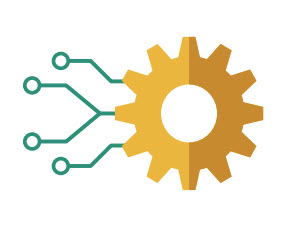The Innovation Gap (Part 2): How To Reboot The Justice System On Technology
Education is the key to changing the mindset of the legal system, and each of you can play a role in making that happen.
 How is it that we can be at this time of unprecedented innovation in legal technology and yet see the justice gap only grow wider? How is it that the justice system is unable to meet the needs of 80 percent of low-income and 60 percent of moderate-income people, when there are so many cutting-edge tools available to streamline and broaden the delivery of legal services?
How is it that we can be at this time of unprecedented innovation in legal technology and yet see the justice gap only grow wider? How is it that the justice system is unable to meet the needs of 80 percent of low-income and 60 percent of moderate-income people, when there are so many cutting-edge tools available to streamline and broaden the delivery of legal services?
As I wrote last week in the first part of this two-part column, the problem is not a lack of innovative technology. It is, quite simply, that the legal system resists innovation. Last week, I explained why I believe the legal system resists innovation. This week, I’ll offer 10 suggestions for what to do about it.
The bottom line is this: If we are ever to provide access to justice to all who are in need, then legal technology must be a central part of the equation — it must be adopted and deployed to its fullest extent. And if technology is ever to be adopted and deployed to its fullest extent, we need to reboot the mind frame of the legal system.

The Ethical use of Generative AI

How do we do that? Here are 10 suggestions.
- Require technology competence.
We fear that which we do not understand and see risk in that which we cannot command. Such is the case with technology. Yet too many lawyers remain technologically incompetent and therefore hinder or obstruct its broader use. Only by requiring lawyers to become competent in technology will we ever get past the fear and ignorance that hold us back.
On this front, we are already making progress. In 2012, the American Bar Association approved a change to Comment 8 of Rule 1.1 of the Model Rules of Professional Conduct, governing lawyer competence, to make clear that competent lawyering includes staying abreast of and understanding the benefits and risks of technology. So far, 28 states have adopted this change.
Sponsored

How To Maximize Productivity With Westlaw Precision With CoCounsel


New Report - Are Small Firms Achieving Their Legal Tech Goals?

Attention Buyer: Not All Legal AI Models Are Created Equal

How To Maximize Productivity With Westlaw Precision With CoCounsel

The potential implications of this rule, I think, are much greater than most lawyers realize.
Two major ethics opinions provide the best guidance we have so far on the meaning of the duty of technology competence. One was a 2015 California opinion dealing with technology in the context of eDiscovery. The other was a 2017 American Bar Association opinion dealing technology in the context of protecting clients’ privileged communications and data.
On three overarching points, the two opinions agree:
- First, both say that, at the outset of every matter, the lawyer has a responsibility to assess the technological issues that may arise and whether the lawyer has sufficient knowledge and skills to competently represent the client with respect to those issues.
- Second, both say that, if the lawyer decides that he or she lacks the competence to handle those issues, then it is OK to bring on someone else who does have the necessary knowledge and skills, such as a colleague or consultant.
- But third — and this is critical — the lawyer in charge of that case, even when a consultant is brought on, retains overall responsibility for supervising the case, for supervising everyone working on the case, and for ensuring that the client’s confidences and best interests are protected, including with respect to the technology issues.
This is an ethical Catch 22. Even if you decide you’re not fully competent with regard to the technology in the case, you still have to have enough competence to be able to make that initial assessment, and you still have to have enough competence to be able to supervise the technology issues for the life of the case.
Sponsored

Mitigating M&A Cyber Risk: Pre- & Post-Acquisition Due Diligence

The Ethical use of Generative AI

Both opinions offer examples of the kinds of issues a competent attorney should be able to assess. Most attorneys, I believe, do not have the degree of competence these opinions suggest they should. The ABA opinion, for example, requires that attorneys be able to understand:
- The nature of any threat to email or data;
- How client confidential information is transmitted and where it is stored; and
- How to use reasonable electronic security measures.
Most lawyers do not even know how to encrypt an email, let alone understand how data is transmitted or how to identify a security threat. These ethics opinions should be wake-up calls to the legal profession. It is time to become competent in technology, and the degree of competence required of you may be greater than you think.
- Require – or at least provide – tech training.
Lawyers should be required to undergo technology training. So far, one state has taken this leap. Florida mandates that all lawyers, as part of their continuing legal education obligation, get training in technology. No other state has yet followed suit, but my guess is that others soon will.
In the absence of requiring technology training, we need to make it widely available and provide incentives for lawyers to take it. One source of such incentives is clients. Many are already demanding that their lawyers be skilled in technology.
An example of this in practice is the Procertas Technology Assessment. Developed by Casey Flaherty when he was general counsel of Kia Motors, the goal was to screen outside counsel for those who lacked basic proficiency in the technologies lawyers use every day: word processing, spreadsheets, and PDF. Not surprisingly, many failed.
Flaherty took the assessment private, creating the company Procertas to make the assessment more widely available. It not only tests lawyers on basic skills, but it also trains them on the skills in which they fall short. For corporate clients, this makes a lot of sense. Lawyers who are proficient in technology are likely to deliver their services more efficiently, at lower cost and with better results.
Another option is to offer formal training programs for lawyers about technology. Unfortunately, outside of CLE programs, few exist. That is why it was notable earlier this year when Suffolk Law School launched a program offering a certificate in legal innovation and technology. Starting this summer, Suffolk will offer a series of six online courses. Lawyers who successfully complete all six will be awarded certification.
- Push (shame) law firms to innovate.
If law firms continue to resist innovation, then why not shame them into innovating?
This was the suggestion of Jim Sandman, president of the Legal Services Corporation, in several recent speeches. Publications such as The American Lawyer routinely rank law firms according to factors such as profitability, diversity or pro bono service. These rankings incentivize firms to do better, so their rankings will improve in the next round. Why not, suggested Sandman, rank law firms on innovation and use of technology?
No magazine took Sandman up on his suggestion, but Daniel W. Linna Jr. did. Last August, Linna, director of The Center for Legal Services Innovation at Michigan State University College of Law, launched the Legal Services Innovation Index. It endeavors to do just what Sandman suggested — rank and compare law firms according to the degree to which they are innovative and make effective use of technology.
Dan makes no secret of the fact that this is directed at clients as much as at the law firms. “My hope,” he says, “is that clients, including legal departments, will consult this index and engage in deep discussions with their lawyers about how to improve legal services delivery.”
- Push (shame) law schools to teach tech and innovation.
The same idea applies to law schools. Overall, law schools do an abysmal job of preparing students for 21st Century law practice. Law schools do not teach the technology tools or skills students will need to succeed. Of course, there are exceptions. A small number of schools are leading the charge for teaching innovation and technology. But other schools need to be pushed or shamed into following suit.
Once again, Dan Linna has stepped up to the plate, building on his Legal Services Innovation Index to launch the Law School Innovation Index. The index rates law schools on the degree to which they teach students about innovative technologies and engage students in using innovative technologies.
One of the schools that’s on that list is Brigham Young University Law School in Provo Utah. Just last week, I wrote about BYU’s LawX lab and its release of an online tool, SoloSuit, developed by students to help low- and moderate-income individuals respond to debt collection lawsuits. The idea of the lab is to have students, over the course of a single semester, research an access-to-justice problem, design a solution, and then build that solution.
This is not only great training for students. It is also of real benefit to those who are without legal help. Although the tool was created to help with cases in Utah, it was designed to be adaptable to any state and even to other kinds of cases. Imagine if every law school were doing this.
- Let go of the idea that lawyers, alone, can close the gap.
We have to let go of the idea that lawyers, alone, can ever close the justice gap. The legal establishment continues to cling to the belief that all we need to do is throw more lawyers at the problem and it will go away — get lawyers to do more pro bono, get more funding for legal services, etc. I’m all for more pro bono and more funding, but lawyers, alone, will never be enough to solve this problem.
Consider these findings from Gillian Hadfield, an economist and law professor at the University of Southern California Law, as reported in the ABA’s 2016 Report on the Future of Legal Services in the United States:
- Lawyers would have to increase their pro bono efforts to over 900 hours a year each to provide some measure of assistance to all households with legal needs.
- To provide just one hour of legal aid to everybody with an unmet legal need would require a budget of $50 billion a year. The current expenditure on legal services from all public and private sources is $3.7 billion.
Lawyers, alone, can never close the justice gap. We have to open the system to other and more innovative ways of delivering legal services.
- Let go of the idea that lawyers are the gold standard.
We have to abandon the belief that lawyers are always the gold standard in delivering legal services. Lawyers hold dearly to this idea and it is a big part of what drives the organized bar’s protectionism. A legal service delivered by anyone (or anything) other than a lawyer, the belief holds, is necessarily inferior.
That is just not true.
Take, for one example, eDiscovery review. During discovery in large litigation matters, it may be necessary to review thousands or even millions of documents to determine which are potentially relevant. Of necessity, lawyers increasingly use technology to assist with this review — it is, after all, physically impossible to manually review such large numbers of documents.
That said, lawyers generally believe that anything short of manual, eyes-on review by a lawyer will produce less-accurate results. Studies, however, demonstrate just the opposite. Technology-assisted review tools that use machine learning can, in fact, produce more accurate results than lawyers alone, and do so in a fraction of the time and a fraction of the cost. The same is true for machine-learning technologies in large-scale contract review.
The fact is that, for certain tasks, technology can be used to enhance the delivery of legal services, even when a lawyer is not involved or only minimally involved, delivering better results with greater efficiency.
- Rewrite the regulatory rules.
If ever there is to be meaningful change, we need to rewrite the rules that regulate the practice of law and the delivery of legal services.
The scope of the problem is such that it is never going to be solved as long as lawyers have a monopoly on the delivery of legal services. We need to open up the delivery of legal services to allow corporate ownership of law firms, because corporations are going to invest in the innovations and scale that will pave the way for legal services to be delivered more efficiently and broadly. To quote Gillian Hadfield:
Meeting demand will require a massive shift in the production technology for legal services to dramatically reduce costs. The only way to achieve the kind of scale and innovation needed is through the corporate practice of law.
We also need to open the delivery of legal services to nonlawyer providers, such as Washington state has done with its limited license legal technicians.
Until we change the rules to allow meaningful and substantive innovations in the delivery of legal services, we’ll never make the progress we need.
- Measure what works and what doesn’t.
Remarkably, there is scant evidence of what works and what doesn’t in the delivery of legal services. In the history of U.S. legal practice, there have been just 50 randomized control trials ever of what works and what doesn’t. The way we practice is basically to say, “I’m a lawyer, trust me, I know what I’m doing,” or “I’m a judge, trust me, I know what I’m doing.” We make critical decisions and life-altering recommendations based on our guts, rather than on evidence and data.
“In no field is resistance to evidence-based thinking more ferocious than in United States legal practice,” says Jim Greiner, director of Harvard Law School’s Access to Justice Lab. Greiner and his team are working to change this state of affairs. They are using randomized control trials to compile evidence-based research aimed at better understanding what works or doesn’t in narrowing the justice gap and delivering legal services.
So is the legal profession welcoming Greider’s research with open arms? Not really. In fact, he’s met a fair amount of resistance from others in the legal field, in part because his research doesn’t always show what people want to hear.
Take this question: Is a tenant in housing court better off receiving limited, lawyer-for-the-day assistance or full legal representation?
Ask 10 lawyers that question and they’ll all give you the same answer: Full lawyer representation is always going to be better than the lawyer for the day.
Yet, in one of his earliest and most-controversial studies, Greiner found otherwise. In a study of tenants facing eviction in housing court, he found no appreciable difference in outcomes between tenants who received full legal representation and those who received limited LFTD assistance.
People can and will quibble with this research and Greiner himself has done subsequent research with varying results. But that is exactly the point. We need evidence-based research to get the answers to these questions. The more we can understand what truly works, then the more progress we’ll be able to make.
- Encourage funding sources to promote innovation and testing.
Organizations that fund legal services should use the power of their wallets to promote innovation and testing.
The Legal Services Corporation has led the way in this respect through its annual Technology Initiative Grants, providing roughly $5 million a year to fund technology innovation in the delivery of legal services. However, beyond these TIG grants, investment in A2J technology is woefully inadequate.
On the state and regional levels, some forward-looking organizations are also investing in A2J technology. The Florida Bar Foundation, to name just one, has been a leader in pushing innovation and technology among its grantees, as have been both the Chicago and Illinois bar foundations among theirs.
But, having recently served as president of the Massachusetts Bar Foundation, I am sensitive to the fact that funders face a difficult balancing act. Thanks to severe cutbacks in IOLTA and other funding sources, their grantees are struggling to meet the demand for their services. To divert money towards technology development is to take it away from direct services.
We can no longer afford to be short sighted. The struggle to keep up with demand will only get worse unless we innovate. Bar foundations and others who fund legal services need to invest some of that money in technology innovation and development. We can’t keep spending all our money trying to plug the dam when what we need is a new dam.
- Push courts to innovate.
Courts must be pushed to innovate. By innovate, I do not mean find better ways to keep doing what they’re doing. Courts need to think differently about who it is they serve and what it means to deliver justice.
Many courts are working hard to both keep up with caseloads and also develop better ways to meet the needs of unrepresented litigants. But courts are stuck in an antiquated model of dispute resolution, a model designed in another era for a system of lawyers and judges, and not for a flood of unrepresented litigants.
Courts need to rethink what they do and how they do it. Perhaps the best example of how technology can be used to resolve disputes is eBay. Early on, eBay realized that, if it was to succeed as a platform for buying and selling, it needed a way to resolve the disputes that would inevitably arise. And it had to be a system that could deal with potentially millions of disputes, often involving small dollar amounts, between buyers and sellers who could be anywhere in world.
Traditional court systems could never work for eBay, so it built its own dispute resolution system. It has been a remarkable success, handling 60 million disputes a year and successfully resolving more than 90 percent, most without third-party assistance.
Courts need to turn away from business as usual and examine alternative ways to address the disputes that come to them and how technology can be part of a solution.
Now, Get Out There and Proselytize
Many of you reading this, like me, live in a legal tech bubble. We get it, and we tend to talk, work and interact with others who get it. We get that technology and innovation enable us to better do our jobs and serve our clients. We understand the potential for technology to play a key role in closing the justice gap.
But those of us in this bubble are the minority. The majority of lawyers remain fearful of technology, ignorant about technology, or just don’t see it as important.
I’ve outlined 10 recommendations for rebooting the legal system’s mindset around technology. But there is one other important piece. Those of us who get it need to break out of our bubbles and spread the word — proselytize, if you will. Blog. Speak. Spread the word.
If you are a lawyer, write about how you use technology in your practice and the benefits you see from it. If you are a developer, let others know what you are working on and what it can do. If you work at a legal aid organization, tell others about how technology helps your organization and clients.
In this post, I’ve written abstractly about how the system needs to change, without directing those recommendations at any specific actor. But everyone who is reading this can take action starting today, by spreading the word about technology and by lobbying bars, courts and institutions to become open to innovation. Ultimately, education is the key to changing the mindset of the legal system, and each of you can play a role in making that happen.
 Robert Ambrogi is a Massachusetts lawyer and journalist who has been covering legal technology and the web for more than 20 years, primarily through his blog LawSites.com. Former editor-in-chief of several legal newspapers, he is a fellow of the College of Law Practice Management and an inaugural Fastcase 50 honoree. He can be reached by email at [email protected], and you can follow him on Twitter (@BobAmbrogi).
Robert Ambrogi is a Massachusetts lawyer and journalist who has been covering legal technology and the web for more than 20 years, primarily through his blog LawSites.com. Former editor-in-chief of several legal newspapers, he is a fellow of the College of Law Practice Management and an inaugural Fastcase 50 honoree. He can be reached by email at [email protected], and you can follow him on Twitter (@BobAmbrogi).







